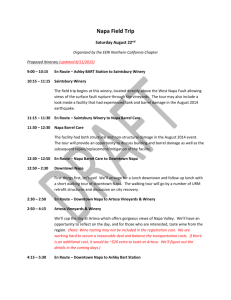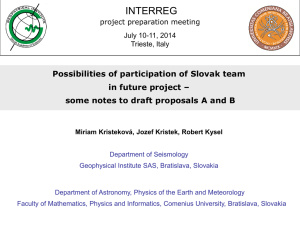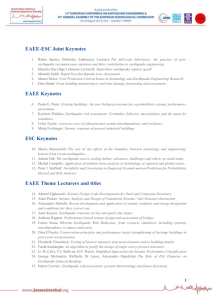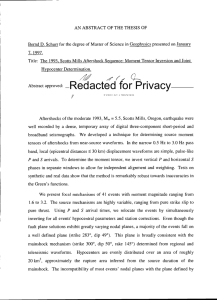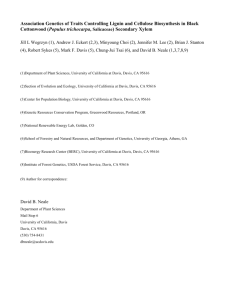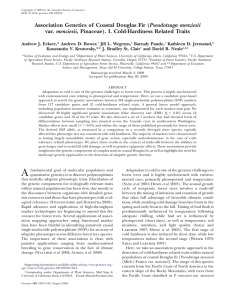grl53322-sup-0001-supplementary
advertisement
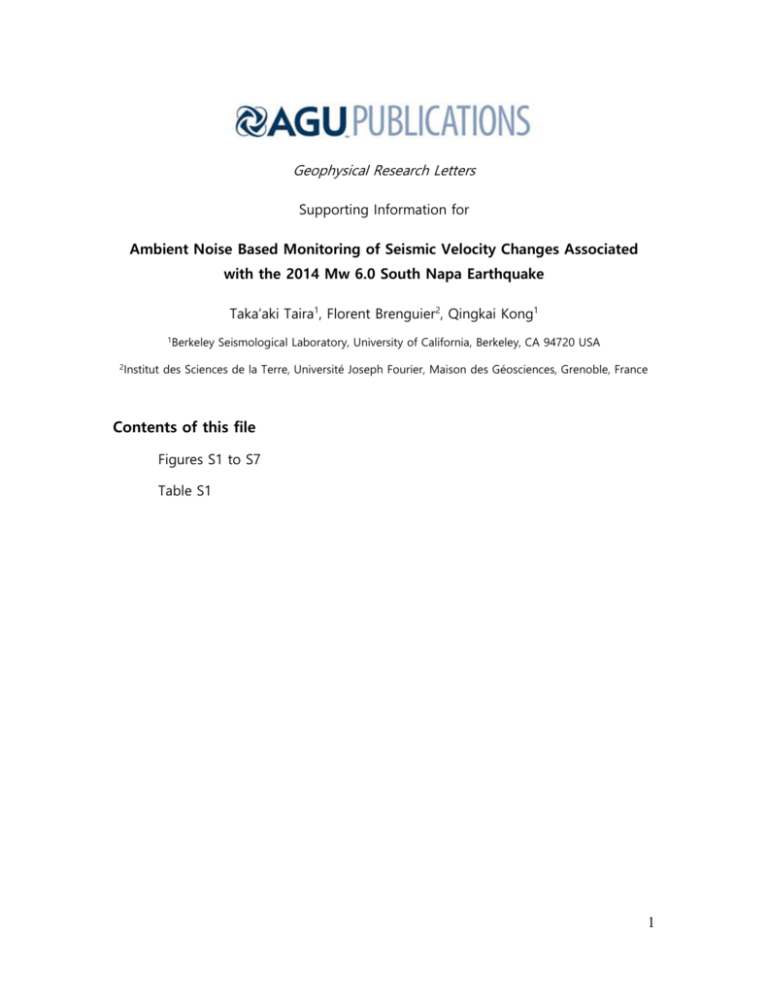
Geophysical Research Letters Supporting Information for Ambient Noise Based Monitoring of Seismic Velocity Changes Associated with the 2014 Mw 6.0 South Napa Earthquake Taka’aki Taira1, Florent Brenguier2, Qingkai Kong1 1Berkeley 2Institut Seismological Laboratory, University of California, Berkeley, CA 94720 USA des Sciences de la Terre, Université Joseph Fourier, Maison des Géosciences, Grenoble, France Contents of this file Figures S1 to S7 Table S1 1 Figure S1. Map view of 12 seismic stations (triangles) and the 2014 Mw 6.0 South Napa epicenter (star). 2 Figure S2. Time histories of relative velocity change dv/v inferred from vertical-vertical component of noise correlation functions (NCFs) with two sigma standard deviations for stack of 5 days in the time intervals (a) September 2010 through May 2015 and (b) July 2014 through May 2015. Note that the dv/v was plotted at the end of the time window for stacking NCFs. Red dashed line is the occurrence time of the 2014 Mw 6.0 South Napa earthquake. Blue dashed lines indicate the 95th percentile range of dv/v distribution obtained from the time interval September 1, 2010 through August 23, 2014. 3 Figure S3. Time histories of relative velocity change dv/v for pair of NHCB057 with a stack of 50 days in the time intervals (a) September 2010 through May 2015 and (b) August 2013 through May 2015. Red dashed line is the occurrence time of the 2014 Mw 6.0 South Napa earthquake. Blue dashed lines indicate the 95th percentile range of dv/v distribution obtained from a one-year of dv/v measurements prior to the South Napa mainshock. Gray area indicates the first 50-75 days of the post-South Napa earthquake period where the median dv/v was evaluated as the coseismic dv/v (orange dashed line). Note that the dv/v measurements in the first 50-75 day postseismic period only include post-South Napa earthquake seismic data. Note also that the dv/v values plotted within the first 50 days following the South Napa mainshock included the pre- and post-mainshock data and the gradual decay of dv/v in this period is an artifact. 4 5 Figure S4. Example for histograms of station dv/v obtained through the Jackknife test for (a) station CVS and (b) station NTO. Dashed lines on each panel indicate the 95th percentile range. 6 Figure S5. Volumetric strain changes at depths of (a) 0 km and (b) 10 km (color scales are saturated). Triangles are seismic stations and the star is the epicenter of the 2014 South Napa earthquake. 7 Figure S6. Peak ground velocity (PGV) measurement from the California Integrated Seismic Network (http://www.cisn.org/shakemap/nc/shake/72284586/pgv.html). Triangles are seismic stations and the star is the epicenter of the 2014 South Napa earthquake. 8 Figure S7. (a) dv/v measurements (gray circle) with the estimated seasonal component (red line). Also shown are the residual velocity changes (green squares) between dv/v and the seasonal component. (b) Daily precipitation collected at the Napa region (station code ALT) extracted from http://cdec.water.ca.gov. 9 Table S1. Locations of sites and their sensors installed and installation types. Station Latitude Longitude Elevation Deptha of site (m) (m) Sensor Installation type CVSb 38.3453 -122.4584 333 - STS2 Surface NAPC 38.4395 -122.2527 739 - L4 Surface NHC 38.4395 -122.3577 5 - L4 Surface NLHb 38.1228 -122.1492 193 - L4 Surface NMI 38.0760 -122.2585 50 - L4 Surface NSP 38.2002 -122.4644 183 - L4 Surface NTO 38.1436 -122.4497 25 - L4 Surface NVA 38.4156 -122.1165 831 - L4 Surface B057b 38.0273 -122.5655 33 213 Sonde-2 Borehole CMABb 38.0689 -122.2291 25 142 GS-11D Borehole PETB 38.1189 -122.5011 1 113 GS-11D Borehole VALB 38.1215 -122.2753 5 156 HS-1 Borehole a Depth of borehole sensor from the surface (m). b Three-component seismic data were analyzed in this study. 10


